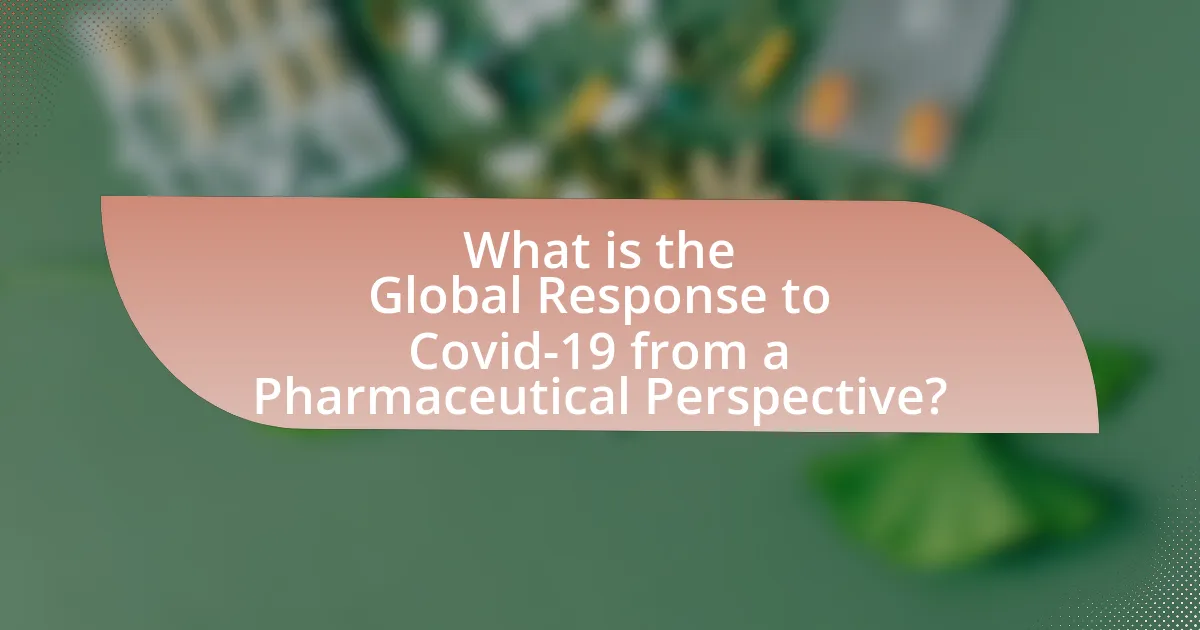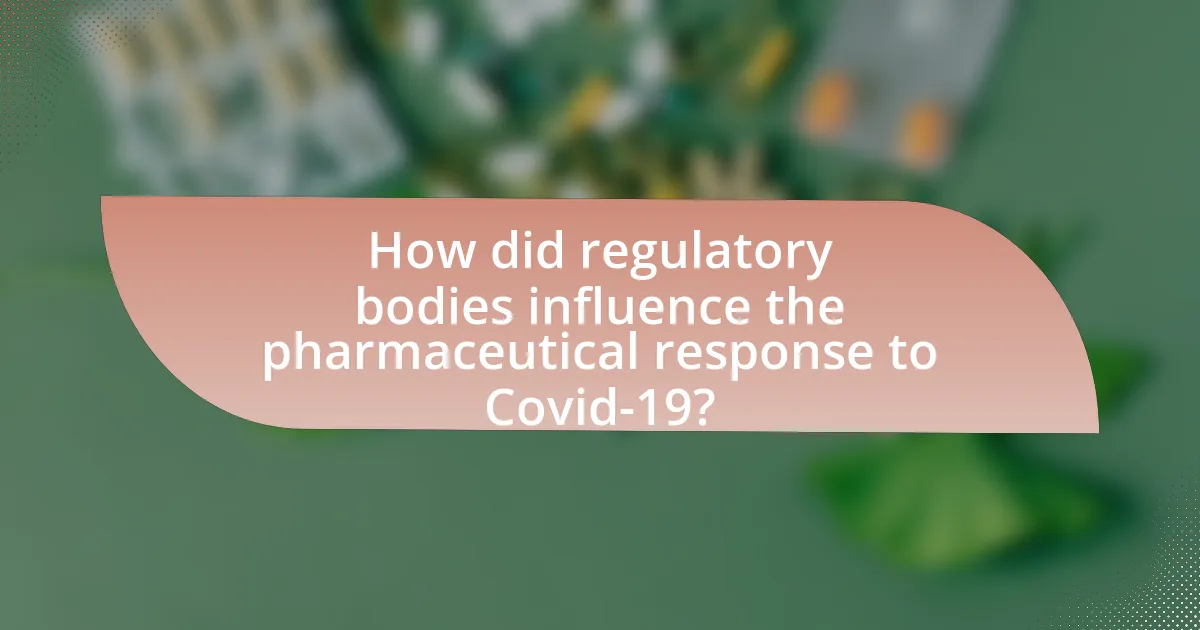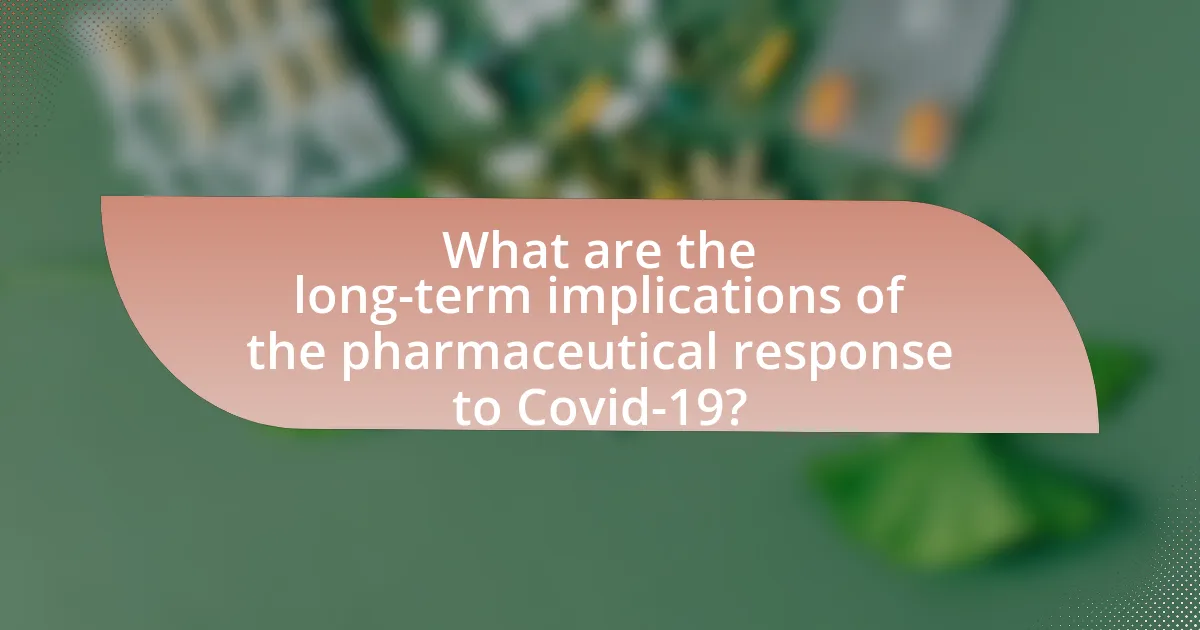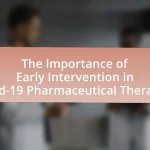The article examines the global response to Covid-19 from a pharmaceutical perspective, highlighting the unprecedented collaboration among pharmaceutical companies, governments, and health organizations in developing and distributing vaccines and treatments. It details the rapid mobilization of resources, the efficacy of mRNA vaccines, and the role of initiatives like Operation Warp Speed and COVAX in ensuring equitable access. The article also addresses the challenges faced by the pharmaceutical industry, including supply chain disruptions and regulatory hurdles, while emphasizing the long-term implications for vaccine development and public health strategies. Key innovations and best practices derived from this response are discussed, providing insights into how future pandemics may be managed more effectively.

What is the Global Response to Covid-19 from a Pharmaceutical Perspective?
The global response to Covid-19 from a pharmaceutical perspective involved unprecedented collaboration among pharmaceutical companies, governments, and health organizations to develop, manufacture, and distribute vaccines and treatments. As of October 2023, over 13 billion vaccine doses have been administered worldwide, with mRNA vaccines, such as those developed by Pfizer-BioNTech and Moderna, demonstrating high efficacy rates of approximately 95% in preventing severe illness. Additionally, antiviral treatments like Paxlovid have been authorized for emergency use, significantly reducing hospitalization rates. This rapid response was facilitated by initiatives like Operation Warp Speed in the United States, which allocated billions in funding to accelerate vaccine development and distribution. The global effort also included equitable access initiatives, such as COVAX, aimed at ensuring that low- and middle-income countries receive vaccines.
How did the pharmaceutical industry initially respond to the Covid-19 pandemic?
The pharmaceutical industry initially responded to the Covid-19 pandemic by rapidly mobilizing resources to develop vaccines and treatments. Major companies, such as Pfizer, Moderna, and AstraZeneca, initiated vaccine research and clinical trials within weeks of the virus’s emergence, leveraging existing mRNA technology and other platforms. By July 2020, multiple vaccine candidates were in advanced stages of development, with Pfizer and Moderna reporting efficacy rates of over 90% in late-stage trials. This swift action was supported by unprecedented collaboration between governments, regulatory agencies, and private sectors, exemplified by initiatives like Operation Warp Speed in the United States, which provided funding and logistical support to accelerate vaccine development and distribution.
What were the first actions taken by pharmaceutical companies in response to Covid-19?
Pharmaceutical companies’ first actions in response to Covid-19 included initiating research and development for vaccines and treatments, as well as ramping up production capabilities. Companies like Moderna and Pfizer quickly pivoted to develop mRNA vaccines, leveraging existing technology to expedite the process. Additionally, firms such as Gilead Sciences focused on repurposing existing antiviral drugs, like remdesivir, to treat Covid-19 patients. These actions were driven by the urgent need to address the global health crisis, with many companies collaborating with governments and health organizations to facilitate rapid clinical trials and regulatory approvals.
How did global collaboration among pharmaceutical companies evolve during the pandemic?
Global collaboration among pharmaceutical companies significantly intensified during the pandemic, driven by the urgent need for rapid vaccine development and treatment solutions. Companies formed unprecedented partnerships, such as the collaboration between Pfizer and BioNTech, which led to the swift development of one of the first COVID-19 vaccines, demonstrating the effectiveness of shared resources and expertise. Additionally, initiatives like the COVID-19 Vaccine Global Access (COVAX) facility emerged, aiming to ensure equitable access to vaccines worldwide, further highlighting the collaborative efforts across the industry. These partnerships not only accelerated research and development timelines but also facilitated the sharing of data and technology, ultimately leading to the production of multiple vaccines within a year of the virus’s emergence.
What role did vaccine development play in the global response?
Vaccine development played a crucial role in the global response to COVID-19 by enabling rapid immunization of populations, which significantly reduced transmission rates and severe disease outcomes. The development of multiple vaccines, such as those by Pfizer-BioNTech and Moderna, occurred within unprecedented timelines, with emergency use authorizations granted in late 2020. This swift action was supported by global collaborations, including initiatives like COVAX, which aimed to ensure equitable access to vaccines worldwide. As of October 2023, over 13 billion vaccine doses have been administered globally, demonstrating the effectiveness of vaccination campaigns in controlling the pandemic and allowing for the gradual reopening of economies and societies.
How were Covid-19 vaccines developed so rapidly?
Covid-19 vaccines were developed rapidly due to unprecedented global collaboration, advanced technology, and significant funding. The use of mRNA technology, which allows for quicker vaccine design and production, played a crucial role; for instance, the Pfizer-BioNTech and Moderna vaccines were developed within months of the virus’s genetic sequence being released in January 2020. Additionally, regulatory agencies like the FDA implemented emergency use authorizations, expediting the approval process while maintaining safety standards. This combination of scientific innovation, financial investment exceeding billions of dollars, and streamlined regulatory processes enabled the swift development and distribution of effective vaccines.
What are the key differences between the various Covid-19 vaccines?
The key differences between various Covid-19 vaccines include their technology platforms, efficacy rates, dosing schedules, and storage requirements. For instance, mRNA vaccines like Pfizer-BioNTech and Moderna utilize messenger RNA to instruct cells to produce a protein that triggers an immune response, achieving efficacy rates of approximately 95% and 94%, respectively. In contrast, viral vector vaccines such as Johnson & Johnson’s Janssen use a harmless virus to deliver genetic material, with an efficacy rate around 66%. Additionally, the dosing schedule varies; Pfizer and Moderna require two doses, while Johnson & Johnson is a single-dose vaccine. Storage requirements also differ significantly; mRNA vaccines need ultra-cold storage at -70°C, while the Johnson & Johnson vaccine can be stored at standard refrigeration temperatures. These differences impact distribution strategies and public health responses globally.
What challenges did the pharmaceutical industry face during the pandemic?
The pharmaceutical industry faced significant challenges during the pandemic, including supply chain disruptions, increased demand for medications and vaccines, and regulatory hurdles. Supply chain disruptions occurred as manufacturing facilities were forced to close or reduce operations due to lockdowns, impacting the availability of raw materials and finished products. Increased demand for COVID-19 vaccines and treatments strained production capacities, leading to competition for resources among companies. Regulatory hurdles included expedited approval processes that required rapid data collection and analysis, which posed challenges in ensuring safety and efficacy while meeting urgent public health needs. These factors collectively hindered the industry’s ability to respond swiftly and effectively to the pandemic.
How did supply chain disruptions impact vaccine distribution?
Supply chain disruptions significantly delayed vaccine distribution by causing shortages of essential materials and logistical challenges. For instance, the COVID-19 pandemic led to factory shutdowns and transportation restrictions, which hindered the production and delivery of vaccines. According to a report by the World Health Organization, these disruptions resulted in a 30% reduction in vaccine availability in several regions during critical rollout phases. Additionally, the lack of timely access to raw materials, such as vials and syringes, further exacerbated the delays, impacting global vaccination efforts and public health outcomes.
What ethical considerations arose in the development and distribution of Covid-19 treatments?
Ethical considerations in the development and distribution of Covid-19 treatments included equitable access, prioritization of vulnerable populations, and transparency in clinical trials. Equitable access was crucial as disparities in healthcare systems could lead to unequal treatment availability, particularly in low-income countries. Prioritization of vulnerable populations, such as the elderly and those with pre-existing conditions, was necessary to ensure that those at highest risk received timely care. Transparency in clinical trials was essential to build public trust and ensure informed consent, as seen in the rapid development of vaccines under emergency use authorizations. These considerations were underscored by the World Health Organization’s emphasis on fairness and justice in health interventions during the pandemic.

How did regulatory bodies influence the pharmaceutical response to Covid-19?
Regulatory bodies significantly influenced the pharmaceutical response to Covid-19 by expediting the approval processes for vaccines and treatments. For instance, the U.S. Food and Drug Administration (FDA) implemented Emergency Use Authorizations (EUAs) that allowed for the rapid deployment of Covid-19 vaccines, such as the Pfizer-BioNTech and Moderna vaccines, which received EUA within months of clinical trials starting. This accelerated timeline was crucial in addressing the urgent public health crisis, as traditional approval processes typically take years. Additionally, the European Medicines Agency (EMA) adopted rolling reviews, enabling continuous assessment of data as it became available, further facilitating timely access to effective therapies. These regulatory adaptations were essential in mobilizing pharmaceutical innovation and ensuring that safe and effective Covid-19 interventions reached the public swiftly.
What expedited processes were implemented by regulatory agencies?
Regulatory agencies implemented several expedited processes to facilitate the rapid development and approval of COVID-19 vaccines and treatments. These processes included emergency use authorizations (EUAs), which allowed for the accelerated review of clinical trial data and the approval of products based on preliminary evidence of safety and efficacy. For instance, the U.S. Food and Drug Administration (FDA) granted EUAs for multiple COVID-19 vaccines within months of their clinical trials, significantly reducing the typical approval timeline that can take years. Additionally, regulatory agencies engaged in rolling reviews, where data from ongoing clinical trials were evaluated in real-time, allowing for quicker decision-making. These expedited processes were crucial in addressing the urgent public health crisis posed by the pandemic.
How did emergency use authorizations change the landscape for Covid-19 treatments?
Emergency use authorizations (EUAs) significantly accelerated the availability of Covid-19 treatments by allowing therapies to be used before full regulatory approval. This expedited process enabled healthcare providers to access and administer promising treatments, such as monoclonal antibodies and antiviral medications, during critical phases of the pandemic. For instance, the EUA for remdesivir in May 2020 marked the first antiviral treatment authorized for Covid-19, providing a crucial option for hospitalized patients. The rapid issuance of EUAs facilitated a broader range of treatment options, ultimately influencing clinical practices and improving patient outcomes during the pandemic.
What role did international regulatory collaboration play in vaccine approval?
International regulatory collaboration significantly expedited vaccine approval processes during the COVID-19 pandemic. By harmonizing standards and sharing data, regulatory agencies such as the FDA, EMA, and WHO facilitated faster evaluations of vaccine safety and efficacy. For instance, the Emergency Use Authorization (EUA) mechanisms allowed for simultaneous reviews across multiple jurisdictions, reducing duplication of efforts and accelerating access to vaccines. This collaborative approach led to the rapid approval of vaccines like Pfizer-BioNTech and Moderna, which received emergency authorizations within months of clinical trials beginning, showcasing the effectiveness of international regulatory cooperation in addressing global health emergencies.
How did public health policies affect pharmaceutical strategies?
Public health policies significantly influenced pharmaceutical strategies during the COVID-19 pandemic by prioritizing rapid vaccine development and distribution. Governments implemented emergency use authorizations and funding initiatives, which accelerated the research and production timelines for vaccines. For instance, the U.S. Operation Warp Speed program allocated nearly $10 billion to expedite vaccine development, resulting in the Pfizer-BioNTech and Moderna vaccines being authorized for emergency use within a year of the virus’s emergence. This collaboration between public health initiatives and pharmaceutical companies exemplified how policy frameworks can reshape industry priorities and operational strategies to address urgent health crises effectively.
What impact did lockdowns and social distancing measures have on pharmaceutical sales?
Lockdowns and social distancing measures significantly increased pharmaceutical sales, particularly in the categories of over-the-counter medications, telehealth services, and prescription drugs for chronic conditions. For instance, a report by IQVIA indicated that U.S. pharmaceutical sales rose by 12.5% in 2020 compared to the previous year, driven by heightened demand for medications related to respiratory illnesses and mental health. Additionally, the shift to telehealth during lockdowns facilitated access to prescriptions, further boosting sales in the pharmaceutical sector.
How did public health messaging influence vaccine uptake?
Public health messaging significantly influenced vaccine uptake by effectively communicating the benefits and safety of vaccines, thereby increasing public trust and willingness to get vaccinated. For instance, campaigns that utilized clear, consistent messaging and engaged trusted community leaders led to higher vaccination rates, as evidenced by a study published in the journal “Health Affairs,” which found that targeted messaging increased vaccine acceptance by 20% in specific demographics. Additionally, the use of social media platforms to disseminate accurate information helped counter misinformation, further enhancing public confidence in vaccines and contributing to higher uptake rates during the COVID-19 pandemic.

What are the long-term implications of the pharmaceutical response to Covid-19?
The long-term implications of the pharmaceutical response to Covid-19 include accelerated vaccine development, increased investment in mRNA technology, and heightened global collaboration in public health. The rapid development of Covid-19 vaccines, such as those by Pfizer-BioNTech and Moderna, demonstrated the potential for mRNA technology to be deployed quickly, which may lead to its application in other diseases, including cancer and infectious diseases. Furthermore, the pandemic prompted governments and private sectors to invest significantly in vaccine research and production capabilities, which could enhance preparedness for future pandemics. Additionally, the collaboration among countries and pharmaceutical companies during the pandemic has set a precedent for global health initiatives, potentially leading to improved responses to future health crises.
How has the pandemic reshaped the pharmaceutical industry?
The pandemic has significantly reshaped the pharmaceutical industry by accelerating innovation and collaboration in drug development. For instance, the urgent need for COVID-19 vaccines led to unprecedented partnerships between pharmaceutical companies, governments, and research institutions, exemplified by the collaboration between Pfizer and BioNTech, which resulted in one of the first authorized vaccines within a year of the virus’s emergence. Additionally, the pandemic highlighted the importance of agile manufacturing processes and supply chain resilience, prompting companies to invest in advanced technologies and digital solutions to enhance efficiency and responsiveness. According to a report by McKinsey & Company, the pharmaceutical industry has seen a 30% increase in R&D productivity due to these changes, demonstrating a lasting impact on how drugs are developed and brought to market.
What innovations in drug development emerged from the Covid-19 response?
Innovations in drug development that emerged from the Covid-19 response include the accelerated use of mRNA technology, which enabled rapid vaccine development, and the implementation of adaptive clinical trial designs that allowed for quicker assessment of treatment efficacy. The Pfizer-BioNTech and Moderna vaccines, utilizing mRNA platforms, were developed and authorized for emergency use within a year, showcasing the potential of this technology for future vaccines. Additionally, the use of real-world evidence and data analytics during the pandemic facilitated faster decision-making in drug approvals, exemplified by the Emergency Use Authorization process employed by the FDA. These advancements have set new standards for speed and efficiency in pharmaceutical development.
How might future pandemics be addressed differently based on lessons learned?
Future pandemics may be addressed differently by implementing more robust global surveillance systems and enhancing vaccine development processes. The COVID-19 pandemic highlighted the need for real-time data sharing among countries to identify outbreaks quickly, as seen with the rapid genomic sequencing of the virus. Additionally, the accelerated development and distribution of mRNA vaccines demonstrated the potential for faster vaccine technology, which can be adapted for future pathogens. The World Health Organization’s COVAX initiative also emphasized the importance of equitable vaccine access, suggesting that future responses should prioritize global collaboration to ensure all countries can respond effectively.
What best practices can be derived from the global pharmaceutical response to Covid-19?
The best practices derived from the global pharmaceutical response to Covid-19 include rapid vaccine development, collaboration across sectors, and transparent communication. Rapid vaccine development was exemplified by the unprecedented speed at which mRNA vaccines were created, with Pfizer-BioNTech and Moderna delivering effective vaccines within a year of the virus’s emergence. Collaboration across sectors involved partnerships between governments, pharmaceutical companies, and research institutions, as seen in initiatives like Operation Warp Speed, which facilitated funding and resource sharing. Transparent communication was crucial in disseminating information about vaccine safety and efficacy, helping to build public trust and combat misinformation. These practices highlight the importance of agility, cooperation, and clear messaging in addressing global health crises.
How can collaboration between pharmaceutical companies and governments be improved?
Collaboration between pharmaceutical companies and governments can be improved by establishing transparent communication channels and joint task forces. These initiatives facilitate real-time information sharing regarding vaccine development, regulatory processes, and public health strategies. For instance, during the COVID-19 pandemic, the Coalition for Epidemic Preparedness Innovations (CEPI) successfully brought together governments and pharmaceutical firms to accelerate vaccine research and distribution, demonstrating the effectiveness of collaborative frameworks. Enhanced partnerships can also be supported through public-private funding models, which have been shown to expedite research and development timelines, as evidenced by the rapid creation of COVID-19 vaccines.
What strategies can enhance public trust in vaccines and treatments in the future?
Enhancing public trust in vaccines and treatments can be achieved through transparent communication, community engagement, and robust education initiatives. Transparent communication involves sharing clear, accurate information about vaccine development processes, efficacy, and safety, which can alleviate fears and misconceptions. Community engagement, particularly through partnerships with trusted local leaders and organizations, fosters a sense of ownership and encourages dialogue about health decisions. Education initiatives that provide evidence-based information and address specific concerns can empower individuals to make informed choices. Research indicates that these strategies significantly improve public perception; for instance, a study published in the journal “Vaccine” found that transparent communication and community involvement increased vaccine acceptance rates by up to 30%.


